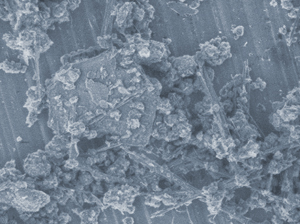UK scientists have analysed the chemistry taking place in storage ponds at nuclear power sites, such as Sellafield, to come up with a way to remove radioactive waste as nuclear regulatory bodies are pressing on the nuclear industry to clean up the ponds.
Storage ponds are used to store spent Magnox rods, which are uranium fuel rods covered by a magnesium-aluminium alloy cladding. The rods contain large amounts of fission products, which are highly reactive. The ponds are maintained to minimise corrosion of the rods, but the cladding corrodes in water, creating fine particle sludge. ‘The sludge in one of these ponds is estimated to contain tonnes of fuel debris including considerable quantities of plutonium,’ says Stephen Parry from the University of Manchester.
Parry, together with his colleagues, made a model of Magnox storage pond liquor to study how plutonium interacts with the corroded Magnox sludge to find a way of removing the plutonium before the ponds are emptied.

A magnified image of nuclear storage pond sludge showing brucite crystals, which sequester plutonium, making it difficult to remove from the mixture
‘One potential problem is the risk that disturbing the sludge will release fine, plutonium-containing particles in the effluent from the ponds. Pond effluents are treated before discharge into the sea under authorisation, but we need to be sure that the treatment process will effectively remove plutonium from the effluents before we can start to empty them,‘ explains Parry.
The team found that a low carbonate concentration, high CMS concentration and high polyelectrolyte concentration resulted in almost all of the plutonium being filtered.
Read the rest of the Chemistry World article…
Or view the Energy & Environmental Science paper:
Plutonium behaviour in nuclear fuel storage pond effluents
Stephen A. Parry, Luke O’Brien, Andy S. Fellerman, Christopher J. Eaves, Neil B. Milestone, Nicholas D. Bryan and Francis R. Livens
Energy Environ. Sci., 2011, DOI: 10.1039/c0ee00390e










